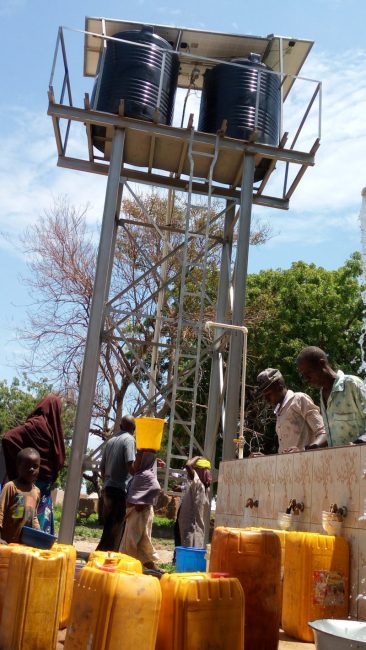The world has a water problem. More than 2.1 billion people drink contaminated water. More than half the global population – about 4.5 billion people – lack access to proper sanitation services. More than a third of the global population is affected by water scarcity, and 80% of wastewater is discharged untreated, adding to already problematic levels of water pollution.

These statistics make for uncomfortable reading but energy can be part of the solution.
The linkages between water and energy are increasingly recognised across businesses, governments and the public – and have been a major area of analysis in the World Energy Outlook (WEO). Thinking about water and energy in an integrated way is essential if the world is to reach the United Nations’ Sustainable Development Goals (SDGs) on water: to ensure the availability and sustainable management of water and sanitation for all.
The connection works in both directions. The energy sector accounts for roughly 10% of total water withdrawals and 3% of total water consumption worldwide. Water is essential to almost all aspects of energy supply, from electricity generation to oil supply and biofuels cultivation. Energy is also required for water treatment and to move water to where it is needed; in a first-of-a-kind global assessment, the WEO found that, on aggregate, the energy consumption in the water sector globally is roughly equal to that of Australia today, mostly in the form of electricity but also diesel used for irrigation pumps and gas in desalination plants.
With both water and energy needs set to increase, the inter-dependencies between energy and water will intensify. Our analysis finds that the amount of water consumed in the energy sector (i.e. withdrawn but not returned to a source) could rise by almost 60% to 2040. The amount of energy used in the water sector is projected to more than double over the same period.
This challenge will be especially acute in developing countries. This is where energy demand is rising fastest, with developing countries in Asia accounting for two-thirds of the growth in projected consumption. This is also where water demand is likely to grow rapidly for agriculture as well as supply to industry, power generation and households, including those getting access to reliable clean water and sanitation for the first time. This growth will lead to higher levels of wastewater that must be collected and treated, and will require that water supply is available when and where it is needed. As such, how the water-energy nexus is managed is critical, as it has significant implications for economic and social development and the achievement of the UN SDGs, especially SDG 6 on water.
Technology is opening up new ways to manage the potential strains on both the energy and water sides, with creative solutions that leapfrog those used in the past. For example, building new wastewater capacity that capitalises on energy efficiency and energy recovery opportunities being pioneered by utilities in the European Union and the United States could help temper the associated rise in energy demand from providing sanitation for all and reducing the amount of untreated wastewater (SDG Target 6.2 and 6.3). In some cases, achieving these targets could even produce energy: WEO analysis found that utilising the energy embedded in wastewater alone can meet more than half of the electricity required at a wastewater treatment plant.
Smart project designs and technology solutions can also help to reduce the water needs of the energy sector (thereby helping to achieve SDG Target 6.4). The availability of water is an increasingly important measure for assessing the physical, economic and environmental viability of energy projects, and the energy sector is turning to alternative water sources and water recycling to help reduce freshwater constraints. There is also significant scope to lower water use by improving the efficiency of the power plant fleet and deploying more advanced cooling systems for thermal generation.
Moreover the achievement of other energy-related SDGs, including taking urgent action on climate change (SDG 13) and providing energy for all (SDG 7), will depend on understanding the integrated nature of water and energy.
Moving to a low-carbon energy future does not necessarily reduce water requirements. The more a decarbonisation pathway relies on biofuels production, the deployment of concentrating solar power, carbon capture or nuclear power, the more water it consumes. If not properly managed, this means that a lower carbon pathway could exacerbate water stress or be limited by it.
Many who lack access to energy also lack clean water, opening up an opportunity to provide vital services to those most in need, provided these connections are properly managed. Pairing renewable decentralised energy systems (off-grid systems and mini-grids) with filtration technologies can provide both accesses to electricity and safe drinking water (Target 6.1). Similarly, linking a toilet with an anaerobic digester can produce biogas for cooking and lighting. Replacing diesel powered generators with renewables, such as solar PV, to power water pumps can help lower energy costs. However, if not properly managed, this could lead to the inefficient use of water, as was the case in the agricultural sector in India.
As such, the IEA’s new Sustainable Development Scenario, which presents an integrated approach to achieving the main energy-related SDG targets on climate change, air quality and access to modern energy, will add a water dimension to this analysis this year. The aim is to assess what the implications of ensuring clean water and sanitation for all are for the energy sector, and what policymakers need to do to hit multiple goals with an integrated and coherent policy approach.
By Molly A. Walton (Energy Analyst, World Economic Outlook)
